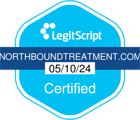There are several different types of benzodiazepine drugs with more than a dozen available by prescription. They’re better known by their brand names: Xanax, Valium, and Klonopin and each have their own potency and uses. As a group, benzos refer to a class of prescription drugs that has a common chemical structure. They all increase activity at receptors for gamma-aminobutyric acid (GABA), a neurotransmitter which slows down the nervous system and produces a calming effect.
Due to this sedative quality, benzodiazepines or “benzos” are primarily prescribed for anxiety, insomnia, other similar stress disorders. One of their biggest advantages is that they’re absorbed into the bloodstream quickly, which means the relaxing feeling can take effect right away. They’re intended for temporary, intermittent use, since the effects of benzodiazepines wear off after a continuous two-week duration.
Different types of benzos are typically broken down into groups by their half-life (i.e. how quickly they’re eliminated from the body) and what they are used to treat. Among the more common ones are:
- Triazolam (Halcion) – A fast-acting benzo with a short half-life prescribed as sleeping pills
- Alprazolam (Xanax) – An intermediate-acting benzo with an intermediate half-life prescribed to treat anxiety and panic disorders
- Clonazepam (Klonopin) – An intermediate-acting benzo with a long half-life prescribed to treat anxiety, insomnia, panic attacks, and seizures
- Diazepam (Valium) – A fast-acting benzo with a long half-life prescribed to treat anxiety, seizures, and alcohol withdrawal)
- Temazepam (Restoril) – An intermediate-acting benzo with an intermediate half-life prescribed to treat insomnia
A short half-life is less than five hours; an intermediate half-life ranges from 5-24 hours; and a long half-life typically exceeds 24 hours. Unless dosages and frequency of use is closely tracked, it’s likely for the body to accumulate a build-up of benzos in the system over time. For example, if a person takes Xanax and the body hasn’t had the chance to fully metabolize the first dose and eliminate it from the system, so starts the accrual process.
As the body becomes used to higher or more frequent dosages, it begins to build a tolerance to the drug. Therefore, the drug isn’t as effective as when first used and it creates a benzo dependency. This can happen with all types of benzos, regardless of how fast they take effect or how long they stay in the body.
Developing Drug Dependency on Benzos
The availability, popularity, and fast-acting effects are why people usually consider benzos their first option when dealing with anxiety disorders or problems sleeping. However, the negative side of benzos is they can easily lead to physical dependence and addiction.
Anxiety affects over 40 million American adults, which is one plausible reason for the increase of benzo prescriptions, which totaled 13.5 million per a 2016 study published by the American Journal of Public Health. Of the different types of benzodiazepines available, Xanax is the top-selling prescription for anxiety. Unfortunately, not all people who take Xanax and other benzos have a prescription. And for those who do, it’s not always taken according to the medical recommendation.
Benzos begin to lose their efficacy after a two-week period. They are meant only as a short-term solution or on an as-needed, infrequent basis. Once someone begins abusing benzos, it doesn’t take long for dependency to set in. The length of time is based on a number of factors, including age, height, weight, and if benzos are being used in combination with other medications, prescription opioids, or alcohol; the latter of which greatly increases the risk of addiction and overdose.
When the body begins to depend on benzos to function, withdrawal symptoms start to occur when it’s not present. These symptoms are largely painful and uncomfortable, causing people to continue their regular use or increase the amount or frequency. Addiction means the body has taken control over what it needs and reacts accordingly when those needs aren’t met.
For anyone who’s ever thought that quitting an addiction was a purposeful choice, they’ll be surprised to know addiction changes the makeup of the brain. It thinks, feels, and acts like it needs the drugs to survive. Due to this intensity, it’s best for a person battling addiction from drugs and alcohol of any kind to seek the help of a treatment facility.
Detoxing from Benzos: What to Expect
Benzodiazepine addiction treatment can be intense– drug withdrawal symptoms from benzos range in frequency and severity. This largely depends on how long you’ve been using benzos and the amount at which you use them. Withdrawal symptoms can start to set in within hours after the last dosage and can last up to two weeks or longer. Symptoms may include:
- Panic attacks
- Sleep disturbance
- Difficulty concentrating
- Nausea and dry heaves
- Tremors
- Seizures
- Heart palpitations
The first few days of detox from benzos are usually the most intense. There’s a chance to experience all of these symptoms at different times and various levels of pain and discomfort. Around the five-day mark, they should begin to subside, but there are cases where they are in full effect all the way up until the end of a typical 14-day period or beyond.
Although these symptoms are expected during the withdrawal period, the actual reaction is individually-based. There’s no way to fully predict how the body will respond when going through detox. In addition to the body’s unpredictable nature, there are also several factors that come into play that differ from person to person. These may include a person’s current mental and physical health, history of use, and previous problems with addiction.
To ensure increased safety and comfort during the detox process, it’s ill-advised to go through the process alone. Since the change to the body results in physical reactions that can be harmful or life-threatening, it’s crucial to undergo this phase of treatment in the care of a team of doctors and therapists who know how to best manage and minimize the side effects of withdrawal following drug abuse.
Plus, it takes being in the right frame of mind in order to power through the difficulty of detox. Having the support of others as motivation and guidance is an important key to the withdrawal process. It helps to prevent relapse and prepare you for the next phase of care. Detox is only the first step in recovery from drug addiction. The physical changes in the body are the reflection of other pains and conditions that need to be addressed in order to fully heal. Without subsequent treatment, it becomes easier to fall back into old patterns and turn to drugs as a way to cope.
Customizing Treatment for a Successful Recovery
The first step of a treatment plan for drug addiction always begins with the detox phase. The body must be fully rid of all substances to allow a person to be in the right physical and mental shape to start moving forward in their recovery process. The next two stages are residential treatment and/or outpatient care.
Residential treatment requires a temporary stay at the chosen treatment facility. This gives a person the opportunity to have access to round-the-clock care and a safe and peaceful space to receive the treatment they need without the distraction or temptation of their everyday life. A recommended stay is four months, but the timeline is finalized based on what’s needed for treatment at this stage.
After completing the residential program, the transition is made to outpatient care where additional support and guidance is given to help a person ease back into the world and ready themselves for their next phase of life. In certain cases, when a person has gone through detox and residential treatment previously, outpatient care can also be useful as a place to offer support and tools to prevent relapse from occurring. This phase usually takes five months.
Beyond these normal routes of care, there’s also the availability of Northbound’s specialized programs that address individual needs. These include:
- Collegebound® – A program that provides mentorship and guidance for those who wish to enroll in college or trade school
- Careerbound® – A specialized program that empowers and assists people who wish to secure employment
- Dialectical Behavior Therapy (DBT) – This program is led by DBT-trained therapists to teach participants DBT skills to gain better awareness, insight, and understanding into their recovery
- Trauma Program – This program is designed for those who have suffered psychological trauma and require an integrated treatment approach
- Music Program – A program that promotes healing through self-expression by engaging with music
- Family Program – A program that allows family members to reconnect to those who are going through treatment and begin to repair damaged relationships as a result of drug abuse
These programs are an integral part of a successful recovery and round out the treatment timeline to equal one year of continuous sobriety. They address the differences of care people require based on their own unique experience.
Treatment gives people a chance to identify and unravel the various pieces that led to their reliance on benzos to begin with. A holistic approach to the cumulative care that’s required to touch all aspects of addiction creates a better pathway for people to heal and maintain their sobriety in the future.
Sources:
- Publishing, Harvard Health. “Benzodiazepines (and the Alternatives).” Harvard Health, Mar. 2014, www.health.harvard.edu/mind-and-mood/benzodiazepines_and_the_alternatives.
- Garrison, Ashleigh. “Antianxiety Drugs – Often More Deadly than Opioids – Are Fueling the next Drug Crisis in US.” CNBC, CNBC, 3 Aug. 2018, www.cnbc.com/2018/08/02/antianxiety-drugs-fuel-the-next-deadly-drug-crisis-in-us.html.
- “Benzodiazepine and Z-Drug Safety Guideline.” Kaiser Permanente, Jan. 2019., https://wa.kaiserpermanente.org/static/pdf/public/guidelines/benzo-zdrug.pdf
- Greenblatt, D J, et al. “Benzodiazepines: a Summary of Pharmacokinetic Properties.” British Journal of Clinical Pharmacology, U.S. National Library of Medicine, 1981, www.ncbi.nlm.nih.gov/pmc/articles/PMC1401650/.
- Pétursson, H. “The Benzodiazepine Withdrawal Syndrome.” Addiction (Abingdon, England), U.S. National Library of Medicine, Nov. 1994, www.ncbi.nlm.nih.gov/pubmed/7841856.











